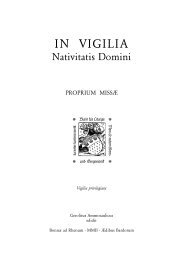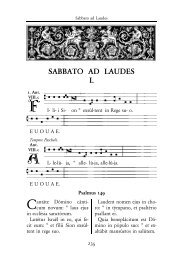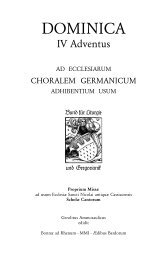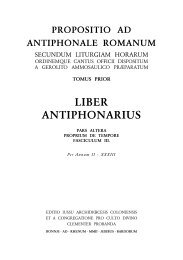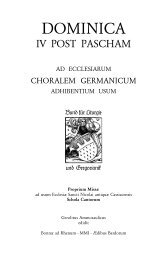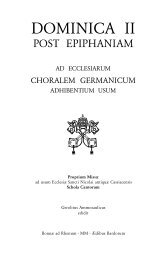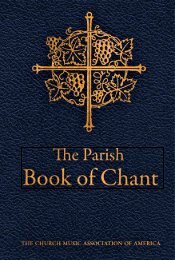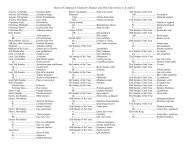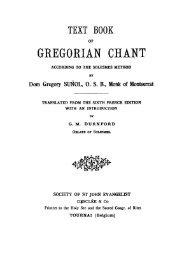The Bugnini-Liturgy and the Reform of the Reform - MusicaSacra
The Bugnini-Liturgy and the Reform of the Reform - MusicaSacra
The Bugnini-Liturgy and the Reform of the Reform - MusicaSacra
You also want an ePaper? Increase the reach of your titles
YUMPU automatically turns print PDFs into web optimized ePapers that Google loves.
a<strong>the</strong>r than being considered New Testament counterparts <strong>of</strong> <strong>the</strong> psalms,<br />
built on <strong>the</strong> principle <strong>of</strong> paralklismus membrorum. This is why <strong>the</strong>ir psalm-like<br />
arrangement in <strong>the</strong> new breviary appears to be so unnatural.<br />
This lack <strong>of</strong> sensitivity to <strong>the</strong> structure <strong>of</strong> <strong>the</strong> Hours is evident not only<br />
in changing <strong>the</strong> position <strong>of</strong> <strong>the</strong> hymns but also in ano<strong>the</strong>r innovation <strong>of</strong> <strong>the</strong><br />
<strong>Bugnini</strong> liturgy: <strong>the</strong> fusion <strong>of</strong> Lauds <strong>and</strong> Vespers with <strong>the</strong> Mass. In <strong>the</strong> history<br />
<strong>of</strong> liturgy, three examples <strong>of</strong> this combination are known: <strong>the</strong> attachment<br />
<strong>of</strong> Lauds to <strong>the</strong> midnight Mass <strong>of</strong> Christmas, <strong>the</strong> addition <strong>of</strong> Vespers<br />
at <strong>the</strong> end <strong>of</strong> Mass on Holy Thursday, <strong>and</strong> <strong>the</strong> shortened Vespers (or Lauds,<br />
respectively) sung at <strong>the</strong> conclusion <strong>of</strong> <strong>the</strong> Easter Vigil Mass. All three go<br />
back to a unique situation <strong>and</strong> find <strong>the</strong>ir explanation <strong>the</strong>rein. Besides, none<br />
<strong>of</strong> <strong>the</strong>m disturbs <strong>the</strong> integrity <strong>of</strong> <strong>the</strong> Office <strong>and</strong> <strong>the</strong> Mass; <strong>the</strong> Hour is sung<br />
as a whole between <strong>the</strong> communion <strong>and</strong> <strong>the</strong> postcommunion, i.e., at <strong>the</strong><br />
end <strong>of</strong> <strong>the</strong> Mass. According to <strong>the</strong> <strong>Bugnini</strong> liturgy, <strong>the</strong> hymn <strong>and</strong> <strong>the</strong> psalms<br />
are to be sung before <strong>the</strong> Mass, whereas <strong>the</strong> canticle from <strong>the</strong> Gospel<br />
comes after <strong>the</strong> communion, which means that <strong>the</strong> Hour has practically<br />
been broken down into its constituent parts; its psalms mean an unjustified<br />
prolongation <strong>of</strong> <strong>the</strong> beginning <strong>of</strong> <strong>the</strong> Mass, <strong>the</strong> mixing <strong>of</strong> two liturgical<br />
cycles, each <strong>of</strong> which requires a different attitude. Cut <strong>of</strong>f from <strong>the</strong> psalmody<br />
<strong>and</strong> <strong>the</strong> rest <strong>of</strong> <strong>the</strong> Hour, <strong>the</strong> canticle functions as a simple song <strong>of</strong><br />
thanksgiving. This solution is to be considered particularly dangerous if it<br />
is not <strong>the</strong> exception but <strong>the</strong> rule, as in some parishes, monasteries <strong>and</strong> seminaries,<br />
etc. He who experiences <strong>the</strong> Hours in this form day by day cannot<br />
form a proper notion <strong>of</strong> <strong>the</strong>ir proportions <strong>and</strong> <strong>the</strong> logic <strong>of</strong> <strong>the</strong>ir structure.<br />
I feel no desire to listen to a symphony by Beethoven between <strong>the</strong> second<br />
<strong>and</strong> third movements <strong>of</strong> a Mozart symphony, not even by way <strong>of</strong> exception,<br />
<strong>and</strong> much less to see it established as general performance practice.<br />
<strong>The</strong> life-like structure expressing <strong>the</strong> character <strong>of</strong> <strong>the</strong> Hours has fallen<br />
victim to <strong>the</strong> enforcement <strong>of</strong> a principle contrived at <strong>the</strong> <strong>of</strong>fice-desk. <strong>The</strong><br />
structure that had been followed by 500 Office rites through 1500 years<br />
<strong>of</strong> liturgical history has been rejected, indeed prohibited (!) by <strong>the</strong> 501 st<br />
Office. Do <strong>the</strong> votes <strong>of</strong> 500 count so little against 1? Can this inconsiderate<br />
procedure claim our inner loyalty <strong>and</strong> affection beyond external compliance?<br />
<strong>The</strong> adinventiones suae, defying <strong>the</strong> overwhelming majority, are audacity;<br />
if, however, <strong>the</strong>y are aimed at eliminating <strong>the</strong> majority, an impudence;<br />
<strong>and</strong> if for achieving this my obedience to <strong>the</strong> Church is required, <strong>the</strong>n,<br />
violence.<br />
18




